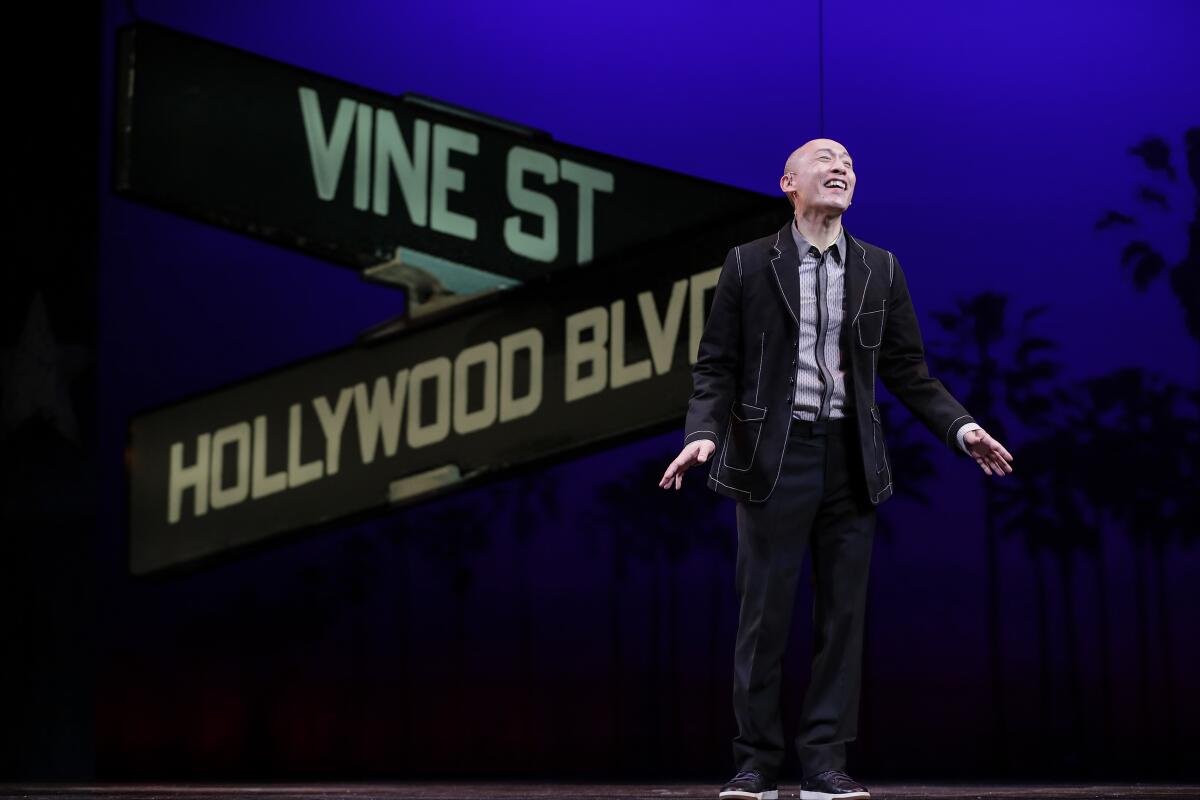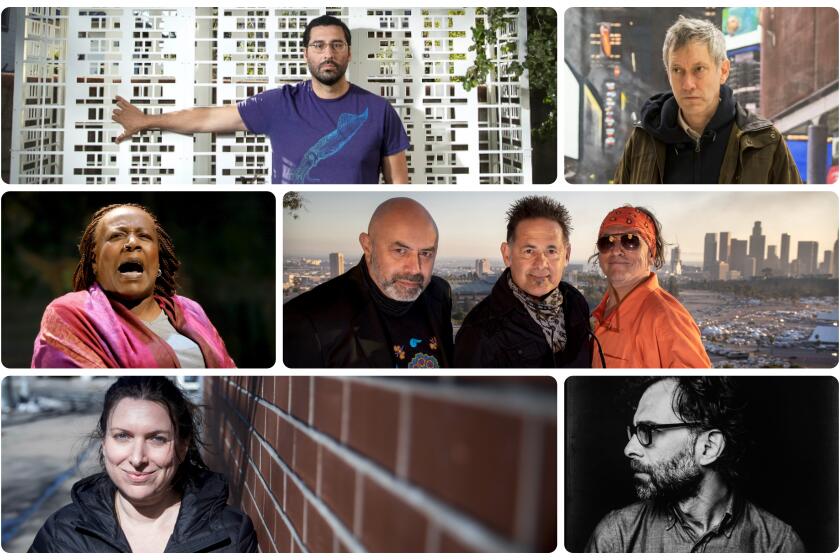Representation isn’t just about visibility. Shootings remind us it’s about life and death

- Share via
“Who lives, who dies, who tells your story?” In a single line from the final song of “Hamilton,” Lin-Manuel Miranda nails the cultural struggle of our age.
The battles of #OscarsSoWhite, #MeToo, Black Lives Matter and cancel culture are part of the escalating war over the American narrative. The conflict isn’t only about who tells the story but also how it is being told. What are the assumptions of the storyteller? Whose experience is being prioritized? And, most important, which audience is being addressed?
Also, what are the barriers to other versions of the tale? And whose story might be precluded or shortchanged by this account?
These questions took on new urgency after eight people — seven of them women and six of Asian descent — were killed last week near Atlanta. Law enforcement charged a 21-year-old man with murder but was reluctant to categorize this targeted mass shooting as a hate crime. For Capt. Jay Baker of the Cherokee County Sheriff’s Office, the default identification was not with the nonwhite victims but with the white suspect, who was apparently suffering not from acute white supremacy and misogyny but from an unfortunate sex addiction. The guy, in Baker’s perversely sympathetic words, was having a “really bad day.”
As this story was stoking outrage, smaller media controversies were percolating into clearer context. The newly appointed editor of Teen Vogue was forced to resign before she officially started after complaints were raised again about anti-Asian and homophobic tweets she posted a decade ago. And the Hollywood Foreign Press Assn., the sketchy organization that decides the Golden Globes, was in crisis mode, working out a remedial plan for the lack of Black journalists among its voting bloc.
These cases may seem unrelated, but they are all connected to the charged politics of representation. At issue is the matter of visibility, of being seen as a human being, endowed with those supposedly inalienable rights of life, liberty and the pursuit of happiness.
Daniel Fish, Culture Clash, Dael Orlandersmith, Richard Maxwell, Annie Dorsen and Lars Jan reveal much loss — but also see a way forward.
I have to confess that I have in the past been skeptical of the way awards have become a flashpoint in the fight for diversity. As a culture, we care way too much about trophies, mistaking the capricious sentiments of an antiquated club for meritocratic excellence. I’d rather the Oscars, Grammys, Emmys and Tonys lose their cachet and that the Golden Globes be spoken of only in tones of jocular derision.
But I’m belatedly understanding the implications of this heated discussion. It’s because awards still hold such sway in determining which future stories get told and which artists get to tell them that they’re worth our political attention. Careerism and ego — the ugly side of the awards business — are distractions from the more urgent concern of narrative equity.
Why should storytelling matter so much? Because it conditions us to respond to society. Artists teach us what to take notice of and what to turn away from, whom to empathize with and whom to tune out. Plato thought this power too consequential to be entrusted to poets, whom he would ban from his ideal republic, leaving the politics of representation in the hands of philosopher kings. Today, this authority is vested in studio executives. So instead of Plato’s high-minded totalitarian state, we have an oligarchy of suits who care more about profit than truth.
After a year of disruption, of not being permitted to see a movie or a play in a theater, perhaps now, on the brink of reopening, we might take a moment to examine our relationship to art. Why do we go to cinemas, concert halls and museums? Is it to deepen or distract ourselves? Are we looking to confirm or challenge what we have come to believe? Is it about sharing culture or hoarding it?
Consuming glittering operas or prize-winning fiction is not by itself a noble act. Marcel Proust satirized those “celibates at the shrine of art” who “extract nothing from their impressions” yet “think they are accomplishing something by shouting ‘Bravo, bravo’ at the tops of their voices after the performance of a work they enjoy.”
He was no great advocate for the social utility of art. For him, music, literature and painting were private affairs. But in the final book of “Remembrance of Things Past,” he makes one of the most potent defenses of art ever written:
Through art alone are we able to emerge from ourselves, to know what another person sees of a universe which is not the same as our own and of which, without art, the landscapes would remain as unknown to us as those that may exist in the moon. Thanks to art, instead of seeing one world only, our own, we see that world multiply itself and we have at our disposal as many worlds as there are original artists, worlds more different one from the other than those which revolve in infinite space, worlds which, centuries after the extinction of the fire from which their light first emanated, whether it is called Rembrandt or Vermeer, send us still each one its special radiance.
The invitation from artists to explore new frontiers is simultaneously an opportunity for self-expansion. I have seen more plays in my lifetime than is medically advisable, but I’m grateful that my range of experience has been widened by encounters with characters I might not have otherwise met. Our sensibility is a source of pleasure and should be indulged. But it’s equally vital that we venture beyond our backyards. The theater, at the highest level, is a school, and its curriculum is empathy.
Tracy Quan, a novelist and an advocate for sex workers, urges more focus on American “puritanism” as an underlying cause of the Atlanta-area spa killings.
Atrocities like the killing of George Floyd and the Atlanta-area shootings should make it clear that we’re talking about life and death. Art, after all, humanizes. From the blur of generic type, it retrieves the individual. Homicidal maniacs may be beyond the reach of such cultural intervention, but the rest of us — witnesses of our society’s fragile pluralism — ought to be able to imagine lives that are too often disregarded even after tragedy.
In the last week, I’ve been thinking about the immigrant workers in Martyna Majok’s plays, the house cleaners, caregivers and sweatshop drones of “Ironbound,” “Cost of Living” and “Queens.” And I’ve been haunted by what happened to playwright David Henry Hwang, who included in his book for “Soft Power” (the musical he wrote with Jeanine Tesori that had its premiere at the Ahmanson Theatre in 2018) his experience of being stabbed while carrying groceries near his Brooklyn home.
“The police will not end up finding my attacker,” the playwright’s surrogate, DHH, reveals at the end of the musical. “My crime will remain unsolved. Their best theory will be that I was targeted because of my appearance. That my assailant mistook me for an Asian delivery person. Then ran away when I yelled, ‘What the …!’ in unaccented English. And left me to die.”
Hwang survived, but DHH reflects on a lasting wound: “I thought I was protected. My parents had come to America, to this land where I’ve been able to tell my story. Of feeling like an outsider — in a nation built by outsiders. But now, the ballot box has given power to those whose America no longer includes people like me.”
Under Donald Trump’s presidency, the forces of hate were abetted for short-term political gain. Art is a mighty corrective to this darkness. But it can’t do the work alone. Our full participation is required.
More to Read
The biggest entertainment stories
Get our big stories about Hollywood, film, television, music, arts, culture and more right in your inbox as soon as they publish.
You may occasionally receive promotional content from the Los Angeles Times.












